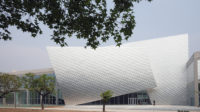Having developed a reputation for precisely detailed, exquisitely refined buildings, the Tokyo-based firm SANAA faced a very different kind of challenge with the New Museum in Lower Manhattan: Design a building for an anti-establishment museum in a scruffy-but-gentrifying part of town. Do it on a tight budget. And be careful, because the critics are weary of museums that are either formal extravagances or dull containers. Against the odds, SANAA, headed by Kazuyo Sejima and Ryue Nishizawa, has delivered a building that pleases both the critics and the public. Its New Museum, which rises seven stories on the Bowery, points the neighborhood in a new direction—out of a previous era of flophouses and gin mills and toward a time of creative engagement. Whether by design or coincidence, its off-kilter arrangement of stacked boxes alludes to a moment of instability—in New York’s cultural scene, economic future, and demographic mix. Instead of glossing over the city’s reckoning with unsettling forces, the New Museum brings it front and center—an attitude that seems just right for an organization founded in 1977 by a curator, Marcia Tucker, the day after she was fired by the Whitney Museum of American Art. For the next three decades, the New Museum bounced around Lower Manhattan, carrying out its mission to show provocative contemporary artwork.
SANAA won the commission in an invited competition in 2002 (beating out David Adjaye, Reiser Umemoto, Abalos-Herreros, and Gigon/Guyer) with a scheme that would make any New York City developer blanch—purposefully using less square-footage than allowed by the local zoning ordinance. By pulling back from the zoning envelope in a series of slipped boxes, the design created the opportunity for roof terraces and long skylights along alternating edges. “We could have built another 20,000 square feet,” says Lisa Phillips, the current director, who took over the museum from Tucker in 1999. “But in return, we got a [60,000-square-foot] building that’s open and has light.” While the final building sports only one roof terrace (on the seventh floor), skylights run along at least one side of each of the three gallery floors, bringing filtered daylight into all of the main exhibition spaces.
Best known for buildings with perfectly honed skins—such as the Glass Pavilion at the Toledo Museum of Art, in Ohio [RECORD, January 2007], and the 21st Century Museum of Contemporary Art, in Kanazawa, Japan [RECORD, February 2005]—SANAA struggled with the wrapping for the New Museum. Originally, the architects thought they would tightly clad each of the stacked boxes in a different metal with hairline joints in between. But this proved too expensive for the $50 million budget and seemed too elegant for the neighborhood and the client. So they tried an approach at odds with their earlier works, something they called “beautiful rough,” says Toshihiro Oki, a project architect for SANAA.
“We moved away from a flat surface and explored ways of getting a rough, blurry effect,” says Oki. Eventually, they developed a skin made of expanded metal mesh set an inch and a half in front of corrugated aluminum panels. Although the aluminum mesh is an industrial standard, the architects expanded its proportions beyond anything commercially available and gave it an anodized finish. To attach it to the corrugated backing, they customized off-the-shelf clips. The result is a building dressed in a metal-mesh stocking, exuding a slightly hazy sexiness that’s neither too classy nor too trashy for the new Lower East Side.
PeopleOwner
Architect
Associate Architect
Client Representative:
Project Management
Construction Management Construction Team: Michael Porcelli, Mark Pankoff, Susan Ospina, Lou Silbert, Kyle Rolf, Anthony Turturro, Rich Bergen, Andrew Sciame, Charles Hsu, Ralph Thompson, Darrin McIntyre, Adam Giusti
Engineers Structural Engineer: Mechanical/Hvac Engineer:
Consultants Fire Protection: Victor Gomez Electrical Systems: Code Consultant: Facade Consultants: Vertical: Audio/ Visual And I.T. Consultant: Security Consultant: Lighting Consultant: Food Facilities Consultant: Waterproofing/ Roofing Consultant: Cost Estimators: Fire Alarm Consultant: Geotechnical Engineer: Concrete Consultant: Education Center Interiors 5th Floor:
Contractor Structural steel stud framing: Marino Ware Gypsum sheathing: DensGlass Gold, Georgia Pacific Waterproofing: Henry Air-Block, Henry Company |
ProductsSuperstructure Exterior Materials Interior Finishes Offices: Carpeted floors, drywall, drywall Ceilings Multi-purpose Room 7th floor: Poured epoxy floor, low iron glass storefront windows wrapping space to terrace, drywall, acoustical plaster Ceiling Façade Cladding Expanded aluminum mesh with anodized finish (custom): Stainless steel mesh clips (custom): James & Taylor, UK Mesh and clip engineering / procurement: James & Taylor, UK Extruded aluminum liner panel (custom): McGrath Inc. Windows Aluminum frame windows: Wausau Windows Storefront Curtain Wall Glass: Starphire Glass door pivot hardware: Rixson Glass door handles: C.R. Laurence Co. Loading dock doors (custom): Competition Architectural Metals Inc. Interior Wall Gypsum board: USG Stud framing: Marino Ware Paint: Sherwin Williams Skylight Skylight system: Supersky Glass: Solarban, PPG Lighting Fluorescent lighting: Bartco Lighting Gallery busway lighting: LSI Downlights: Lucifer Lighting Company Custom Millwork Elevator: Epoxy Floor 7th Floor: Glass Tiles: Bathrooms Acoustical Plaster Ceiling 7th Floor: Plumbing Toilets/urinals: Toto Doors/Frames: Michbi Doors Inc., NY
|












